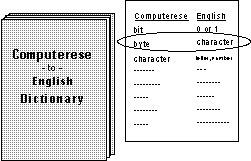Byte
Character
made from a group of bits.
Acronym: By = Ch-mf-a-gob (pronounced
Chuh-muf-uh-gawb).
- The term byte (biit) is derived from binary bite or binary term (your choice).
- A byte is composed of a group of off /on conditions represented by bits.
- Each byte is equivalent to one character. A character can be a letter, number, or symbol.






